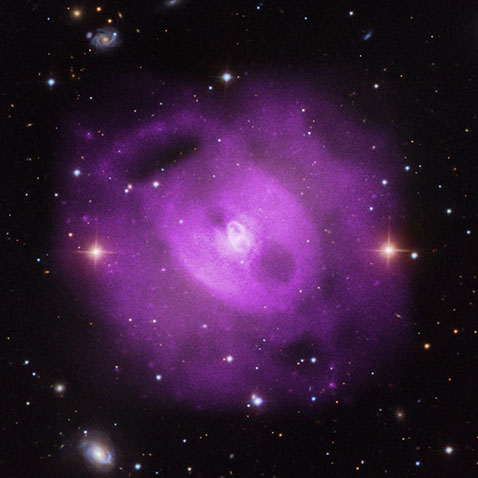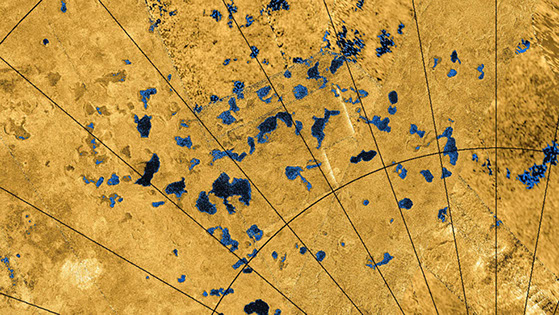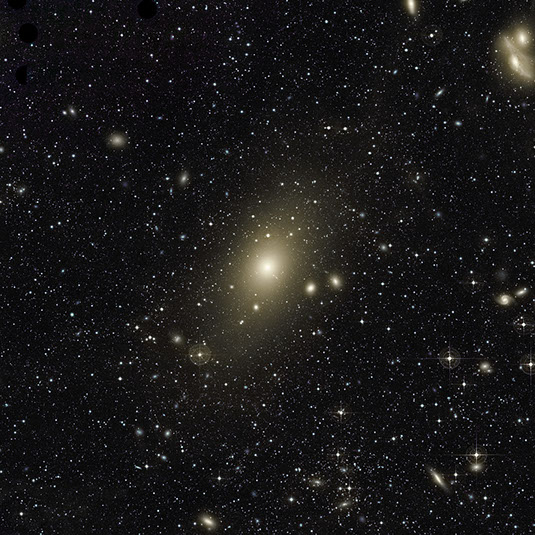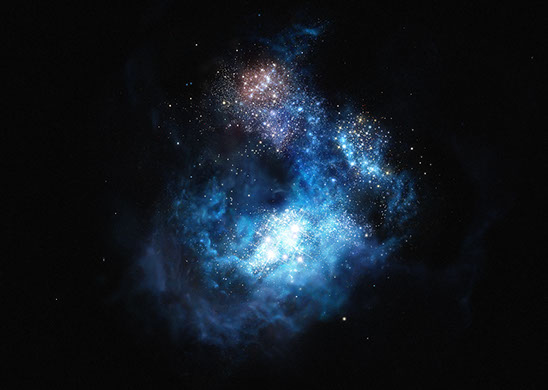

July 2015
Multiple Black Hole Eruptions
Nasa's Chandra X-ray Observatory has been looking at the history of black hole eruptions in NGC 5813, a group of galaxies located 105 million light years from Earth. Galaxy groups and galaxy clusters are groups of galaxies located near each other and are surrounded by giant amounts of hot gas that emit X-rays.
As objects fall into the black hole, eruptions take place that send gases out into space in jets. The black hole's spin produces a rotating tower of magnetic field that generates shock waves and pushes the gases outward.
Chandra has found three pairs of cavities, or bubbles, that were formed in three different eruptions from the black hole. Each of the pairs has a shock front, as seen in the photo as sharp edges. Close examination shows the shock fronts are a bit blurred, however, indicating turbulence in the gas. The speed of the gas is measured at about 160,000 miles per hour (258,000 kilometers per hour).
Measuring the energy in the cavities indicates that the newest cavity pair is still forming. The rate of energy production is the same in all pairs, but the youngest pair has total less energy. Theory indicates that this means the third pair will continue to grow at that rate of energy production until the total energy produces matches the other pairs.

This is a combination of X-ray data from Chandra (shown in purple) and Optical light (red, green and blue) Credit: NASA/CXC/SAO/S. Randall et al. (X-ray), SDSS (optical)
Measuring the Mass of an Exoplanet
Scientists have now been able to measure the mass of an exoplanet. Using the Kepler space telescope, exoplanets are found when they pass in front of their star. By measuring the star's light when the planet is in front of it and not in front of it, scientists can determine the size of the planet. But mass is a different story. Knowing the mass, along with the planet size, will tell scientists about the makeup of the planet, whether it is a rocky planet or gas planet for example.
If only one planet orbits the star, scientist can measure the minuscule movement of the star caused by the gravitational tug of the planet. But when several planets orbit the star, this method does not work. Now scientists have determined another approach.
Each planet is ever so slightly influenced by its neighbor planets. Each planet slows down or accelerates as it obits the star and this measurement can be used to determine the mass of the planet.
Kepler measured both the mass and size of the planets orbiting the star Kepler-138 in the constellation Lyra. Kepler-138 is located about 200 light years from Earth and is about half the size of our sun.
The inner-most planet is Kepler-138b and is about the size of Mars. Using the data of size and mass, it was determined that Kepler-138b is a rocky planet with a composition much like Mars and Earth.
The outer planets were also measured. Kepler-138c is Earth sized and is probably also rocky like the Earth is. But Kepler-138d is less dense and cannot be made of the same mix of materials like the Earth.
Even though these planets may be much like Earth is composition, they are all in obit too close to the star for liquid water to exist and support life as we know it.
Upcoming Launches
Date: July 22
Launch Vehicle: Soyuz
Launch Site: Baikonur Cosmodrome, Kazakhstan
Description: Expedition 44 to take Kjell Lindgren (NASA), Kimiya Yui (JAXA) and Oleg Kononenk (Roscosmos) to the International Space Station
Archived Issues
The Lakes of Titan
There is only one place in the solar system, outside of Earth, that we know of where lakes and seas exist on the surface - Saturn's moon Titan. It is too cold for water to exist in liquid form on Titan (-292 degrees Fahrenheit (-180 C)). But liquid methane and ethane fill these lakes instead of water.
But how did the lakes form in the first place? A new study of data returned from the NASA/ESA Cassini spacecraft indicates that the lakes formed in a process much like sinkholes on Earth form.
Cassini has found two types of lakes on Titan. One type is vast seas several hundreds of miles across and several hundred feet deep fed by rivers. The second type are shallow smaller lakes with round edges and steep walls found in flat areas with no rivers feeding them.
The lakes fill up from rainfall and from underground. Over Titan's 30 year seasonal cycle the lakes fill up, then dry out, then are filled again.
On Earth, rainfall and water erosion underground form sinkholes and caves. The Titan lake's physical characteristics are similar. Titan's liquid is hydrocarbons such as methane. By determining how the liquid on Titan falls (in amounts and over time) it was determined that it would take around 50 million years to create a 300 foot (100 meter) depression in Titan's surface.
Most of Titan's lakes are near the polar areas where rainfall is higher than the equatorial regions. Using the equatorial rainfall amounts, it was determined it would take 375 million years to form a 300 foot deep lake.
The results of the study match what we see on Titan. This indicates the natural physical land-shaping processes on Earth may be the same on other worlds even though the chemical makeup is different.

The Lakes of Titan.
Credit: NASA/JPL-CalTech/ASI/USGS
Galaxy Eater
ESO's Very Large Telescope in Chile as revealed that the elliptical galaxy M-87 has swallowed an entire medium-sized galaxy in the past billion years. Astronomers have been able to track over 300 planetary nebulae and has found clear evidence of excess light coming from the devoured galaxy.
M-87 lies at the center of the Virgo Cluster of galaxies and is about 50 million light years away. Since the individual stars are too faint and numerous to examine at this distance, astronomers studied the planetary nebulae. A planetary nebula is the dust and gas blown out from a star when it went supernova.
Following the motions of the nebulae, using the FLAMES spectrograph, ripples and disturbances could be measured. Astronomers could follow how a medium-sized galaxy merged with the larger galaxy. The stars of the medium-sized galaxy spread out now are scattered over an area 100 times larger than they were originally.
It was also determined that the medium-sized galaxy was probably a spiral galaxy with a lot of star forming regions. These star forming regions are now active in M-87.

M-87 is in the center of the photo. The other galaxies in the photo are all part of the Virgo Cluster.
Credit: Chris Mihos (Case Western Reserve University)/ESO
First Generation Stars
Astronomers have discovered the brightest galaxy by far yet found in the early universe. Additionally, they have found strong evidence of examples of first generation stars within it. These previously theoretical objects were the creators of the first heavy elements in history, the building blocks of all the stars, planets and even life. The newly found galaxy is known as CR7 and was discovered using ESO's Very Large Telescope in Chile.
Known as "Population III" stars, these first generation of stars has long been theorized. They were born out of the primordial material from the Big Bang. These first stars were formed out of the only elements to exist prior to stars: hydrogen, helium and trace amounts of lithium. Heavier elements such as oxygen, nitrogen, carbon and iron were formed inside the stars.
Population III stars would have been enormous, up to a thousand times more massive than our sun. They would only live about two million years before exploding in a giant supernova. Up until now the physical proof of these stars has eluded astronomers.
The study looked at the universe about 800 million years after the Big Bang. A number of young bright galaxies were found with CR7 being the brightest, by far the brightest galaxy ever discovered at point in time after the Big Bang.
The instruments found strong ionised helium emission in CR7 but no sign of heavier elements. This was especially important as it provided direct evidence that Population III stars had ionised gas within a galaxy in the early Universe.
Within CR7 astronomers also found bluer and somewhat redder stars indicating that the formation of Population III stars occurred in waves.
Data was obtained from not only the VLT but also from the Keck Observatory and Subaru Telescope as well as the Hubble Space Telescope. As instruments become more and more advanced and accurate, astronomers are beginning to be able to see the beginning of, and creation of the Universe itself.

Artist concept of CR7
Credit: ESO/M. Kommesser
Pluto is Red
As New Horizons approaches Pluto we are now able to confirm that the color of Pluto is red, similar to Mars. But that is where the similarities end. Mars is red because of iron oxide, commonly called rust, in the soil. Pluto is red because of hydrocarbon molecules formed when cosmic rays and solar ultraviolet light interact with methane in the atmosphere and on the surface.
Reddish substances are created when a particular color of ultraviolet light from the sun, called Lyman-alpha, strikes molecules of methane which in turn produces complex compounds called tholins. The tholins drop to the ground to form a red ground cover. New Horizons has found that a diffuse Lyman-alpha glow is falling on Pluto from all directions from interplanetary space and it is strong enough to produce almost as much tholin as the direct rays of the sun. This means that tholin is created at all times, even when the sun is not falling on Pluto. During Pluto's winter, which lasts decades, the sun remains below the horizon all the time. But tholin is still being created and falling onto the surface.
Tholin as been detected on both Saturn's moon Titan and Neptune's moon Triton. Lab experiments on Earth have also been able to produce them when simulating those moon's atmospheric conditions.
As New Horizons gets closer, we will be able to see more and more detail in the surface and learn more about the geology of this unique place. New Horizons will make its closest fly-by on July 14.
© 2014-2016 Ted Cook Productions LLC. - All Rights Reserved